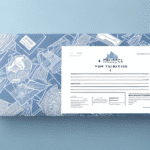What Is a Packing Slip? A Comprehensive Guide
A packing slip is a vital document that accompanies a shipment of goods, detailing the contents of the package. For business owners and managers involved in shipping, understanding and effectively utilizing packing slips can enhance operational efficiency, ensure accuracy in order fulfillment, and improve customer satisfaction. This guide delves into the various aspects of packing slips, their importance, types, and best practices for their creation and management.
Understanding Packing Slips
Why Are Packing Slips Important for Your Business?
Packing slips serve as a record of the items included in a shipment. This documentation is essential for several reasons:
- Order Verification: Customers can verify that they have received all ordered items, reducing the likelihood of disputes.
- Inventory Management: Businesses can track inventory levels more accurately by maintaining detailed records of shipments.
- Error Detection: Comparing the packing slip with the actual shipment helps identify discrepancies, enabling timely corrective actions.
According to a study by Investopedia, effective inventory management can reduce costs by up to 10%, highlighting the significance of accurate packing slips in maintaining inventory integrity.
The Different Types of Packing Slips
While the primary purpose of a packing slip remains consistent, there are various types tailored to specific business needs:
- Standard Packing Slip: Lists all items included in the shipment along with quantities and product codes.
- Pick Ticket: Used internally by warehouse staff to gather items for an order before packaging.
- Commercial Invoice: Required for international shipments, detailing the value of goods, taxes, and duties for customs clearance.
- Customized Packing Slip: Incorporates branding elements like logos and may include additional information such as return policies or promotional offers.
Information Included on a Packing Slip
An effective packing slip should contain the following information:
- Customer Details: Name and address of the recipient.
- Order Information: Order number and date of shipment.
- Item Details: Description, quantity, SKU or product codes of each item.
- Shipping Information: Method and carrier details.
- Additional Information: Pricing details, sales tax, return instructions, or company branding elements.
Ensuring the accuracy of this information is crucial to prevent misunderstandings and maintain customer trust.
Benefits of Using Packing Slips
Implementing packing slips in your shipping process offers multiple advantages:
- Record Keeping: Provides a tangible record of shipped items for both the business and the customer.
- Inventory Tracking: Facilitates real-time inventory monitoring and management.
- Process Standardization: Creates a consistent procedure that can be followed by all team members, enhancing operational efficiency.
- Error Reduction: Minimizes the chances of shipping incorrect items or quantities by providing a detailed checklist.
Enhanced customer satisfaction is another significant benefit. Clear packing slips allow customers to verify their orders promptly, fostering trust and encouraging repeat business.
Creating Effective Packing Slips
Designing a Packing Slip Template
Creating an effective packing slip involves ensuring all necessary information is included and presented clearly:
- Clarity: Use a clean layout with distinct sections for different types of information.
- Branding: Incorporate your company logo and colors to reinforce brand identity.
- Customization: Tailor the template to include additional information like promotional messages or return instructions.
There are numerous free packing slip templates available online that can serve as a starting point. Additionally, software solutions can offer customizable templates to suit specific business needs.
Common Mistakes to Avoid
To maintain the effectiveness of packing slips, avoid the following common mistakes:
- Missing Information: Ensure all critical details, such as customer address and order number, are included.
- Inaccurate Descriptions: Double-check that all items and quantities listed match the actual shipment.
- Outdated Templates: Regularly update templates to reflect any changes in product lines or business processes.
Implementing a review process can help catch and correct these errors before shipments are dispatched.
Customizing Packing Slips for Branding
Customizing packing slips can significantly enhance your brand's presence and customer experience:
- Logo and Colors: Incorporate your logo and brand colors to make the packing slip easily identifiable.
- Personalized Messages: Adding thank-you notes or personalized messages can foster a positive relationship with customers.
- Promotional Offers: Include information about upcoming sales or special offers to encourage repeat purchases.
Managing Packing Slips
Organizing and Filing Packing Slips
Efficient management of packing slips is essential for easy retrieval and audit purposes:
- Centralized Storage: Store all packing slips in a dedicated digital or physical location accessible to relevant team members.
- Systematic Organization: Sort packing slips by order number, date, or customer name to facilitate quick searches.
- Access Control: Ensure that only authorized personnel can access and modify packing slip records to maintain data integrity.
Automating Packing Slip Generation
For businesses handling large volumes of shipments, automating the creation of packing slips can save time and reduce errors:
- Software Solutions: Utilize inventory management or order fulfillment software that automatically generates packing slips based on order data.
- Integration: Ensure that your shipping software integrates seamlessly with other business systems like CRM and ERP for streamlined operations.
- Customization Options: Choose software that allows for easy customization of packing slip templates to match your branding needs.
Examples of such software include ShipBob and ShipStation, which offer robust packing slip automation features.
Leveraging Packing Slips for Business Improvement
Using Data from Packing Slips
Packing slips contain valuable data that can inform various aspects of business operations:
- Inventory Trends: Analyze which products are shipped most frequently to manage stock levels effectively.
- Operational Efficiency: Identify bottlenecks in the shipping process by monitoring packing slip generation times and error rates.
- Customer Insights: Understand purchasing patterns and preferences to tailor marketing strategies accordingly.
Implementing data analytics tools can help extract actionable insights from packing slip data, driving informed decision-making.
Choosing a Third-Party Shipping Partner
When selecting a third-party shipping partner, consider the following regarding their packing slip practices:
- Accuracy: Ensure that the partner maintains high accuracy in their packing slips to prevent order discrepancies.
- Customization: Verify if the partner can customize packing slips to align with your branding requirements.
- Integration: The shipping partner's systems should integrate smoothly with your order management software for seamless packing slip generation.
Reputable shipping partners like UPS and FedEx offer customizable and reliable packing slip services.
Troubleshooting Common Packing Slip Problems
Despite best practices, issues with packing slips can arise. Common problems include:
- Information Errors: Mistakes in item descriptions or quantities can lead to customer dissatisfaction.
- Missing Slips: Slips can get lost during the shipping process, causing confusion and delays.
- Software Glitches: Technical issues may prevent accurate packing slip generation.
To address these challenges:
- Regular Audits: Periodically review packing slips for accuracy and completeness.
- Backup Systems: Implement backup processes to ensure packing slips are not lost and can be regenerated if necessary.
- Technical Support: Maintain a relationship with your software provider for prompt resolution of technical issues.
Conclusion
Packing slips are more than just a list of shipped items; they are a critical component of the shipping and fulfillment process that supports inventory management, error reduction, and enhanced customer satisfaction. By understanding the various types of packing slips, implementing best practices in their creation and management, and leveraging the data they provide, businesses can streamline their operations and foster stronger relationships with their customers.






















